Introduction – A Clash of Cultures
Fought between the Roman Republic and several Gallic tribes (mostly from areas constituting present-day France and Belgium), the Gallic Wars from 58-50 BC for all intents and purposes alluded to the clash of cultures. To that end, the Roman army of the 1st century BC was a disciplined force with a veritable command structure and military organizations. Even the Roman soldiers could be considered close to being ‘professionals’, with their wages paid directly by the state and their military tenures encompassing years of service.
The Gauls, on the other hand, saw warfare as an extension of their culture, with courage and ritualism playing crucial roles in bolstering the morale of the soldiers. And while their elite forces were armed superbly and had experience in conducting raids and battles, the bulk of the Celtic troops lacked any formidable supply system and command chain that could logistically (and strategically) sustain their vast armies on the campaigns for extended periods.
Contents
- Introduction – A Clash of Cultures
- The Armies of the Opposing Forces in the Gallic Wars
- The Chronology of Events and Tactics Involved in the Gallic Wars
- Brutus and His Grappling Hooks (circa 56 BC)
- Caesar, ‘War Crimes’ and Pontoon Bridges (circa 55 BC)
- The Invasions of Britain (circa 55 – 54 BC)
- The Heroism of Cicero (circa 54 BC)
- Druids and the Rise of Vercingetorix (circa 53 BC)
- ‘Scorpions’ to the Roman Rescue at Avaricum (circa 52 BC)
- The Defense of Gergovia (circa 52 BC)
- The Momentous Siege of Alesia (circa late 52 BC)
- The Last Oppidum (circa 50 BC)
- Conclusion – The Slavery Factor
The Armies of the Opposing Forces in the Gallic Wars
Gauls versus Gauls
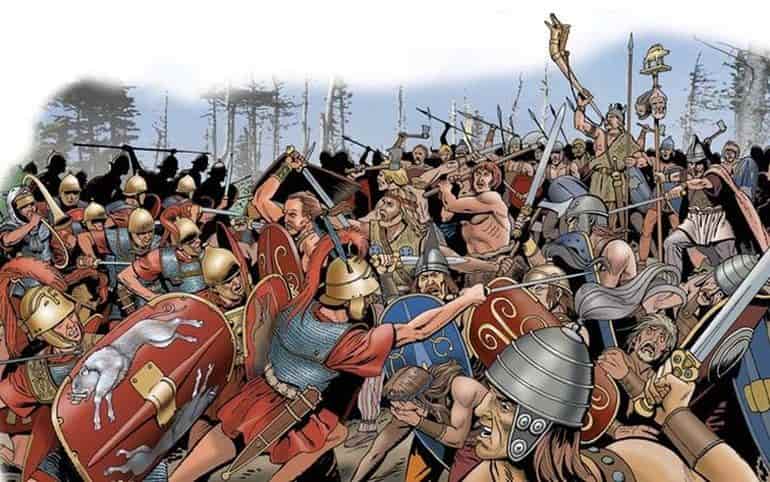
Interestingly enough, while we see the Gallic Wars essentially as a mega conflict between the Romans and the Celts, at least two of Caesar’s initial five legions were composed of troops levied from the areas comprising Cisalpine Gaul, a Roman province that was not integrated into Roman Italy till 42 BC (that is eight years after the end of the Gallic Wars). Simply put, many of these Roman troops were essentially Gauls, though born and brought up under Roman administrative systems (and possibly culture).
Furthermore, while these Romanized Gauls fought in the typical legionary manner with more-or-less uniform arms and armaments, they were further supported by auxiliary troops who were levied directly from allied Gaulish tribes and even distant Germanic realms – most of whom followed their own set of military commands and battlefield tactics.
So in essence, like most conflicts in history, the Gallic Wars didn’t really pit singular civilizations against one another but rather alluded to the encounter between two different spheres of influence then existing in ancient western Europe.
The Multifarious Scope of the Roman Army
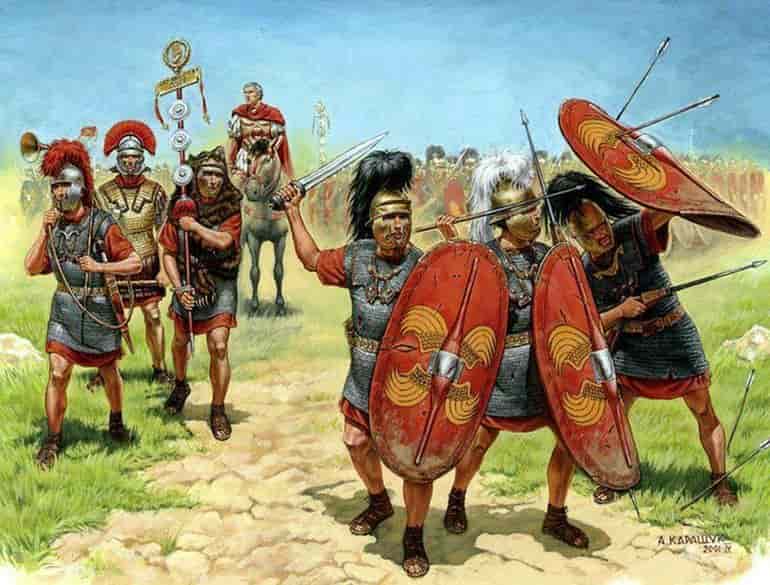
In one of our previous articles about the Roman legionaries, we discussed how all Roman men aged between 17 and 46 were liable for military service – although the peak age for enlistment tended to be skewed towards the early 20s age group. And interestingly, each legionary had to claim his origo (origin) from a city or at least a town.
However, in spite of such claims, the vast majority of the legionaries came from a rural background – possibly because the rural folk were considered to be hardier with higher levels of endurance. As a result, their city-based origo credentials were often fabricated during the time of enlistment, usually by the officials themselves.
And while legionaries tended to be armed uniformly, it was the auxiliaries who truly presented the dynamic scope of the Roman army. Usually recruited from fringe provinces of the Roman Republic along with neighboring states, these auxiliary troops preserved their native brand of fighting styles and tactics.
One apt example would pertain to the use of Gallic and Germanic mounted units by the Roman forces. Possibly recruited from the elite ranks of the Roman allied tribes, these horsemen formed the main cavalry arm of Caesar in his Gallic campaign.
Interestingly enough, given the Roman penchant for flexibility in operations, Caesar even recruited slingers from the Balearic Islands along with skirmishers and archers from distant Numidia and Crete.
The Celtic Warrior
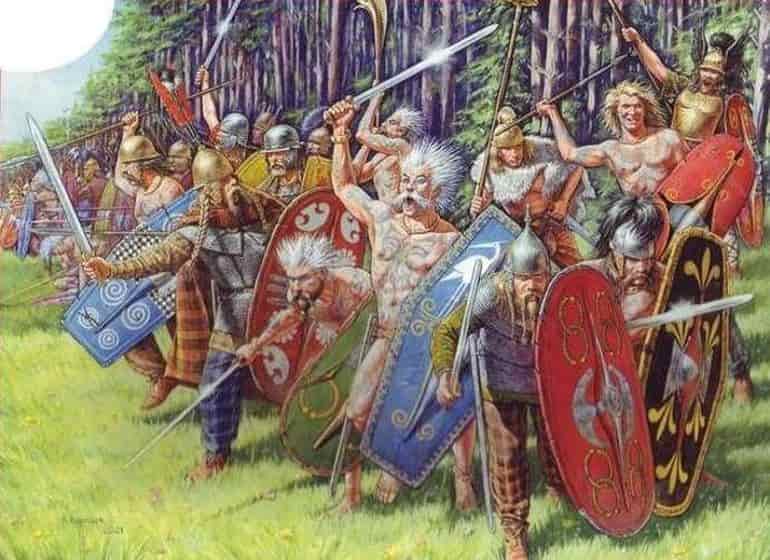
As we mentioned before, the Celts while being one of the warrior societies of ancient Europe, approached warfare as an intrinsic extension of their culture, as opposed to a systematic scope adopted by the Romans with logistical solutions. This translated to varied types of armor worn by their warriors, with the equipment rather mirroring the economic status of the individual (in contrast to the general uniformity of the Roman legionaries).
To that end, the elite and richer sections of the Gaulish tribes exhibited armors and weapons showcasing high levels of craftsmanship – with items like coolus helmets, mail shirts, and long slashing swords. In fact, as a testimony to the refined degree of Gallic craftsmanship, much of the equipment was actually adopted by the Romans themselves.
One should also understand that ancient Celtic society was based on the mutual appreciation of physical security, which in turn endowed the nobles with the power of ‘providing’ security to the commoners. And the scope of security was needed quite regularly since the Celts were often involved in ‘aggressive’ activities, ranging from cattle rustling, slave raiding, and trading to even clan-based vendettas and warfare.
In fact, these bunch of low-intensity conflicts rather prepared the young Celtic warrior for actual warfare, not only psychologically (since courage was not seen as a virtue but rather viewed as expected behavior), but also tactically, like honing his weapon-handling and most importantly demonstrating his martial reputation as a warrior.
The Superior Cavalry
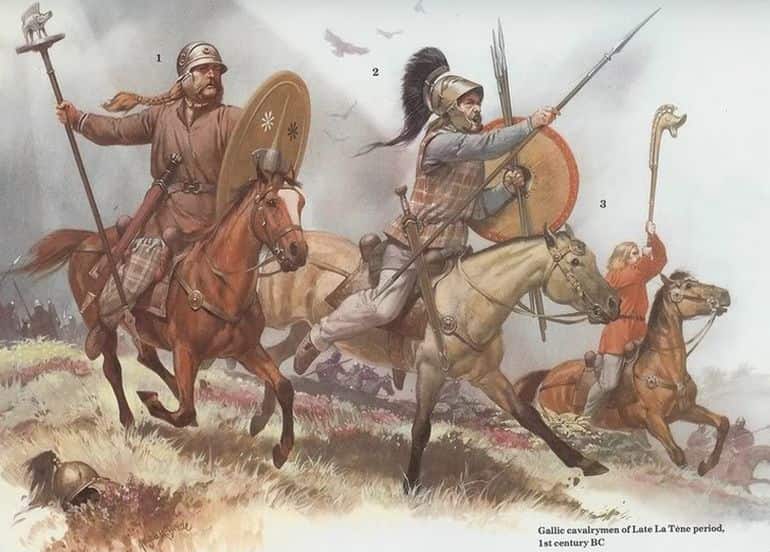
Till now we had mostly talked about the general soldier (and warrior) types of the factions involved in the Gallic Wars. However, while the cavalry was still not the dominant force on the ancient European battlefield (in contrast to medieval times), the Gauls were clearly better in horsemanship when compared to their Roman auxiliary counterparts. One particular example would relate to the acrimonious defeat of the Roman cavalry at the hand of the Nervii horsemen in 57 AD.
And much like the Roman cavalry auxiliaries, the Gaulish cavalry forces were filled by the wealthiest members of their society. Now it should be noted that stirrups were probably not used by these troops, which partly negated their ability to mount cyclic charges on their infantry-based foes, unlike latter-day knights.
However, at the same time, the Celtic saddle design was sturdy and effective enough for a skilled rider to maneuver his sword or spear thrust, while also allowing him to throw javelins and projectiles. And interestingly enough, even beyond the armor and skill of the horse-mounted warrior, there was tactical acumen to consider – like the coordination between some Germanic cavalry and their light infantrymen that shockingly took the Romans by surprise.
The Contrast of Fighting Styles
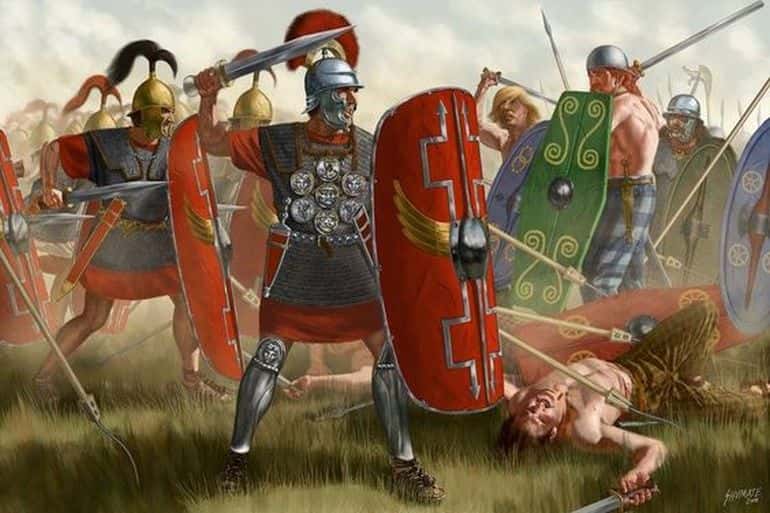
Kate Gilliver in her co-authored book Caesar’s Gallic Wars 58-50 BC says – “Gallic and Roman fighting styles were the complete antitheses of each other.” So in essence, while the end goal pertained to a victory on the chosen battlefield by any means necessary, the approach to warfare in these two cultures was distinctly different from each other.
For example, the Roman military cornerstone was the deep organization of its army, with formations and ‘teamwork’ viewed as preferred factors when it came to dynamic solutions for winning an encounter. On the other hand, the Gauls were motivated by the valor shown on the battlefield through individual deeds, thus making the encounter itself a spectacle where rich nobles and champions could flaunt their ritzy armor, heavy weapons, and indomitable courage.
Now while objectively, both of these approaches had their limitations – with Romans relying heavily on the discipline and training of even their new recruits and Gauls depending on the ardor of their elite warriors to carry forth the day, the Romans clearly had an advantage in close-quarter infantry fighting, especially when it came Gallic opposition.
That was because of the tactical system adopted by the Romans that allowed them to fight in compact formations armed with the gladii (short swords for thrusting). In contrast, the Gauls preferred to swing their arms and long slashing swords – actions that needed space and looser formations.
So in a way, the Roman solid formations countered the Gauls by snatching away the room needed for boisterous weapon swings. Also, such tactics rather aided the Romans to maintain their cohesion and discipline, factors that were ultimately more helpful in winning engagements than the flair of the Celtic champions.
The Chronology of Events and Tactics Involved in the Gallic Wars
Brutus and His Grappling Hooks (circa 56 BC)
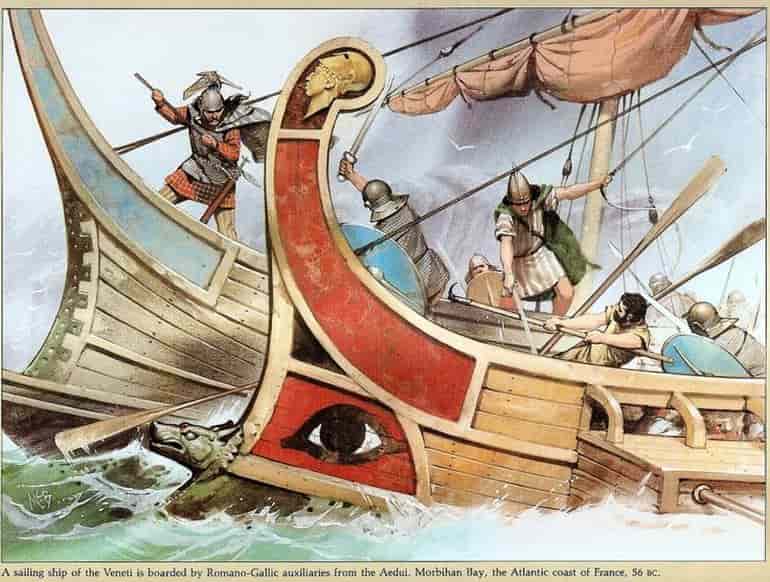
By 56 BC, after two major engagements against the Helvetii and the Nervii, the Romans had established their control (albeit precarious) over the eastern parts of the Gaulish lands. In fact, pertaining to the latter tribe, the Nervii were almost successful in inflicting a heavy defeat on Caesar’s forces, especially after their cavalry triumphed over the Roman auxiliary horsemen – but the day was saved (for the Romans) by reinforcements coming from two inexperienced legions who wheeled back to the battlefield after capturing the enemy encampment.
In any case, now the Romans were pitted against the Veneti, who in spite of losing most of their hill-forts in the land, successfully managed to salvage most of their wealth by virtue of their maritime endeavors. And much of the tribe’s navy, suited to the rough sea water, shifted to the Atlantic coast of Brittany. To that end, the general sturdiness of Venetic ship designs made them almost invincible against ramming.
So as a result, the desperate Roman fleet under the command of one Decimus Brutus (who later became one of the chief instigators of Caesar’s assassination; not to be confused with Marcus Brutus – one of the chief assassins) devised the ingenious tactic of using grappling hooks that would allow them to cut the rigging of the heavy Venetic vessels.
Simply put, this tactic handicapped the maneuvering power of the Venetic ships that were mostly dependent on their sails – thus rendering them immobile targets floating on the high sea (a predicament exacerbated by lack of wind on that fateful day). On the other hand, the Roman ships relied on oars, which allowed them to catch up with the Venetic vessels, and then destroy them in a piecemeal fashion from morning till sunset.
And while this audacious naval ploy worked in favor of the Romans, Caesar was clearly frustrated by the resistance of these seafaring Celtic tribes – as can be discerned by his command to execute many of the Veneti elders and sell high numbers of the Veneti population into slavery.
Caesar, ‘War Crimes’ and Pontoon Bridges (circa 55 BC)
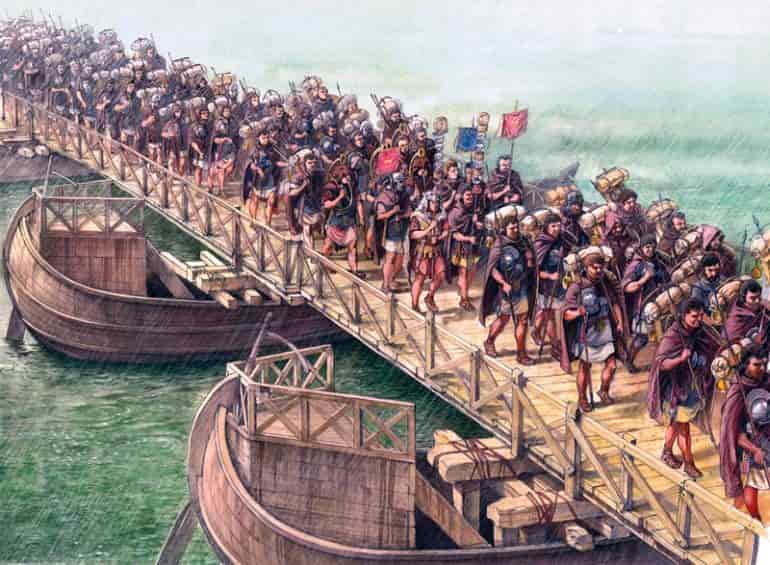
Caesar’s impressive generalship during the Gallic Wars was often accompanied by ‘bloodthirsty’ streaks. One blatant example would relate to the episode (in 55 BC) of the Usipi and Tencteri, both Germanic tribes that resolved to cross the Rhine after being driven out of their own lands by the Suebi. Now Caesar’s policy restricted these tribes to settling in Gaul, and he enforced his statute by sending around 5,000 Roman auxiliary cavalrymen to threaten the Germans.
Unfortunately for the Romans, the Germans with their mixed cavalry tactics (as we mentioned before) and 800 horsemen were able to rout the force and even killed around 74 of the Roman men. Caesar saw this as a grave affront to the Roman army and promptly attacked the German camp.
The aggressive maneuver totally took the Germans by surprise – resulting in the massacre of not only men but also women and children. According to Caesar’s own accounts, his punitive action caused around 430,000 casualties – though the figures were surely exaggerated.
And intriguingly enough, Caesar didn’t just stop at the bloody massacre, he even endeavored to cross the Rhine to further intimidate the Germanic tribes. And Rome’s first invasion of Germany was complemented by ingenuity, with one fascinating example pertaining to the 437 yards (400 m) long floating bridge deployed to cross the Rhine River.
This tactical trick caught some fringe villagers off guard, who were shown the Roman force of arms. After demonstrating his superiority in arms, Caesar promptly withdrew from the Rhine territory and dismantled his hastily-constructed pontoon bridge, all within just 18 days.
And while these actions may seem excessive and brutal, one should also objectively understand that many of the deeds (and crimes) were actually planned by Caesar as publicity stunts to earn prestige among fellow Romans and even Gauls and Germans.
Simply put, in a fervent bid to outmatch his rivals Pompey and Crassus, Caesar couldn’t let go of the opportunity to be the first Roman to invade Germany, which would have boosted both his public image and political mileage. However relating to the latter, there were some political enemies of Caesar who actually threatened to prosecute him on charges of war crimes once Caesar’s governorship term was over.
The Invasions of Britain (circa 55 – 54 BC)
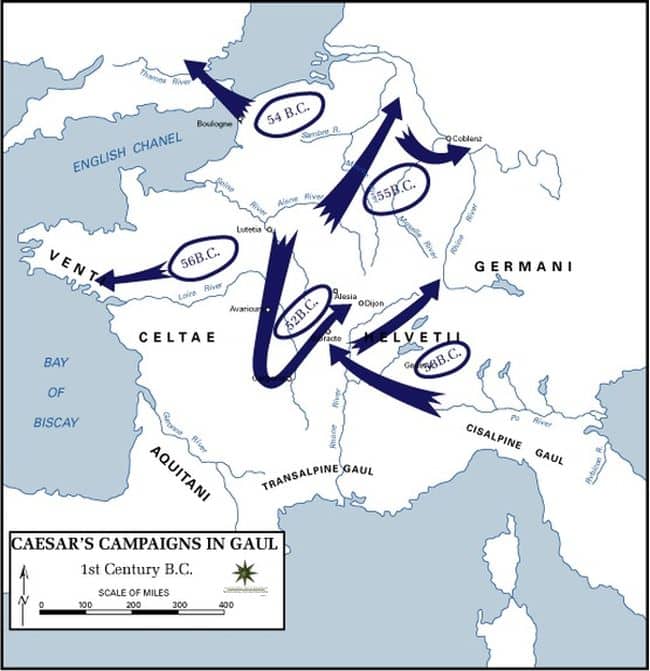
By 55 BC, the Romans had managed to subjugate many Gallic tribes, including the factions of Aquitania (south-west France) as a result of victories under Publius Crassus, the son of Marcus Licinius Crassus and a noted cavalry commander of his day (who led as a junior officer under Caesar, much like Brutus).
They even managed to make a show of their strength by crossing the Rhine and ‘defeating’ some of the Germanic entities. But the act that pushed Caesar into the focal point of public imagination back at Rome arguably relates to the audacious invasion of Britain – an incredible feat that was never tried before by any Roman general.
Caesar even had the casus belli for invading the foreign (and mysterious) land, with reports of the British Celtic tribes (Britons) helping their continental brethren with ‘possible’ military assistance. But much like the Rhine episode, the British campaign was probably more of a calculated move by Caesar to bolster his publicity. Unfortunately, while the notion was clearly cunning the execution lacked in its logistical capacity – with Romans crossing the English Channel at Kent with just two under-prepared legions.
The problems were exacerbated when the supporting cavalry forces were unable to make their landing due to high tides. The army disembarked after much difficulty and struggled their way to build a roughly defensive encampment. But they were already cut off from supplies and the Britons even managed to ambush many of Roman grain harvesters.
A short-pitched battle ensued with the legionaries just being able to hold their positions, and Caesar promptly demanded hostages from the British tribes. But the precarious nature of his expedition becomes quite evident on account of the Romans withdrawing from the Kent coast on the arrival of spring (and thus storm season) before their spurious demands were met – thus making the expedition last only 20 days.
Fortunately for Caesar, his first ‘invasion’ of Britain was wildly celebrated in Rome with a decreed public thanksgiving of 20 days. More importantly, Caesar returned to conduct his unfinished business in Britain in 54 BC. This time around, the Romans were amply supplied by transport ships and reinforced by a total of five legions and two-thousand cavalry.
And while having similar difficulties during landing and also facing hit-and-run resistance from the elusive Britons, the Romans finally scored their first major victory in Britain by defeating a big raiding party. They were also able to storm the Catuvellauni capital, the hill-fort of southern Britain’s most powerful tribe (possibly located in modern Hertfordshire), and consequently, most of the proximate tribes surrendered to the Romans. So finally after negotiating opportune terms of surrender and annual tributes, Caesar returned triumphantly back to Gaul.
The Heroism of Cicero (circa 54 BC)
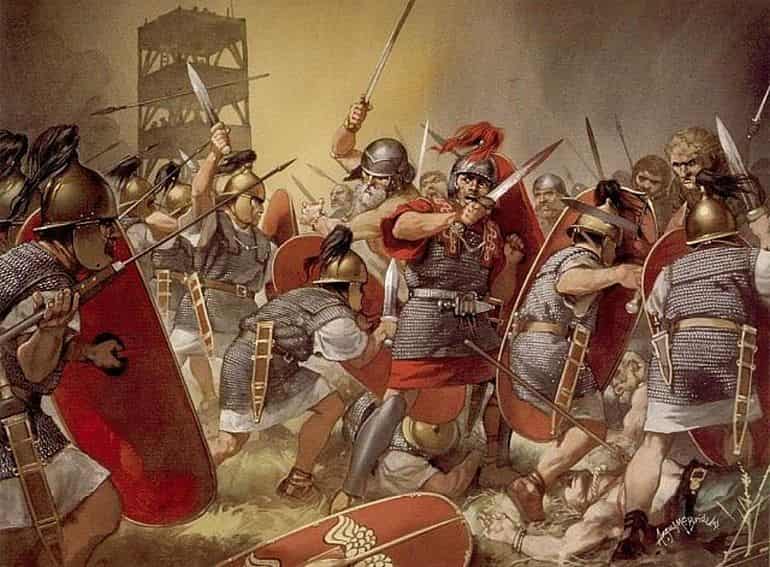
But as history had proven time and again, military dominance always didn’t translate to actual administrative (and cultural) control. And thus while the majority of Gaul was nominally under Roman subjugation, many parts of the vast region were still zones of resentment and insurrection.
One of such open acts of rebellion dearly afflicted the Romans, with Ambiorix and his Eburones tribe (Germanic in origin, though living west of the Rhine) along with northern Gallic allies managing to wipe out an entire legion and five cohorts under Quintus Titurius Sabinus, who wrongly trusted the former’s feigned offering of safe conduct in case of an invasion of Germanic mercenaries.
The result of the unexpected victory encouraged many of the northern Gauls, and thus the instigated Aduatuci, Nervii, and their allies decided to rise up in arms and take the fight to the Romans based on their territory, on the similar pretext of feigning to offer them safe passage (in case of a Germanic invasion). But this Roman camp was under the leadership of Quintus Cicero, the younger brother of the famous orator, and he was resolved to not make the same fatal mistake as his army colleague Sabinus.
And so began the defense of Cicero against a multitude of Gallic forces, with the Nervii even using the Roman tactic of circumvallation (aided by Roman prisoners), wherein the besieged defender was surrounded by a line of fortifications made by the attacker. And while the strategy to trap the Romans with their own device worked initially, Cicero didn’t budge from his defensive position – even after weeks of determined attack by Gallic forces who used siege towers and arson.
However, time was of the essence, and Roman morale and numbers were both dwindling fast. But fortuitously Cicero was able to get his message to Caesar, and the proconsul reacted in a timely fashion by force marching up to 20 miles a day to relieve his stranded officer.
And ultimately Caesar was able to hand down a heavy defeat to a Nervii army (possibly 60,000 strong) that had moved away from the siege to counter the general’s two legions. In any case, it is estimated that Cicero’s defending force suffered around 90 percent casualties – and yet they managed to hold on successfully against the aggression of a now-motivated enemy.
Druids and the Rise of Vercingetorix (circa 53 BC)
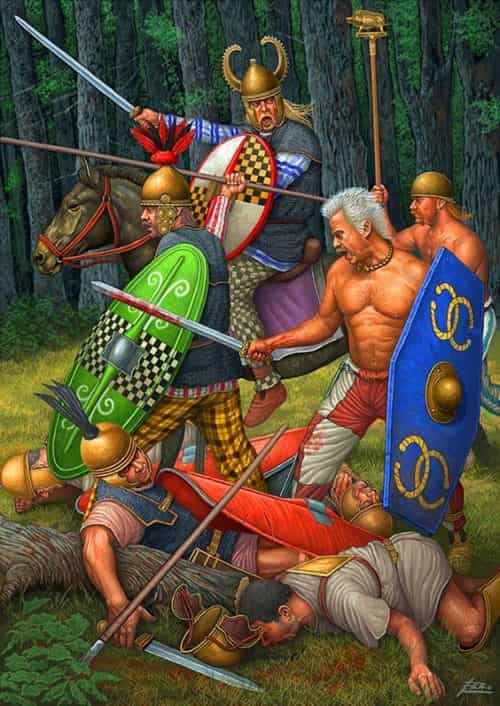
In the following year (circa 53 BC), the Romans under Caesar took the offensive by campaigning against the rebellious elements in north-eastern Gaul. Reinforced by three more legions (two of them being newly raised and one even borrowed from Pompey), Caesar even crossed the Rhine for the second time to intimidate the Germanic tribes that had been supporting the Gauls.
But in spite of victories and punitive measures, the political climate in Gaul was becoming dire for the occupying Roman forces. And finally, in the winter of 53 BC, a large-scale revolt ensued, (possibly) partially fueled by Caesar’s notion of transforming Gaul into a full-fledged Roman province.
Interestingly enough, while previously Gallic tribes fought as separate political entities against the Romans, many of them were now united on the basis of what they perceived as socio-religious ‘duty’. One of the reasons for this incredible outcome was because of the instigation of the Carnutes, who more-or-less occupied the central ‘sacred’ lands of Gaul where druids customarily met to settle disputes between various tribes.
These regions were militarily vulnerable to the approaching Romans, which in turn gave a young, charismatic Arvernian noble named Vercingetorix the opportunity to create a ‘grand’ coalition of defending Gallic tribes.
Additionally, it should be noted that the Roman Republic’s precarious position in Gaul was further exacerbated with the onset of winter that logistically threatened to cut off its armies from supplies. And while the Romans did successfully capture many fortified Gallic towns (oppida) on their way to crust the revolt, Vercingetorix adopted the defensive strategy of not offering the Romans direct battle.
Instead, the Gauls frequently raided Roman foraging parties, abandoned their own oppida, and even followed a scorched-earth policy in a bid to deplete the enemy supplies (and morale), and thus snatch away their momentum to operate at full scale.
‘Scorpions’ to the Roman Rescue at Avaricum (circa 52 BC)
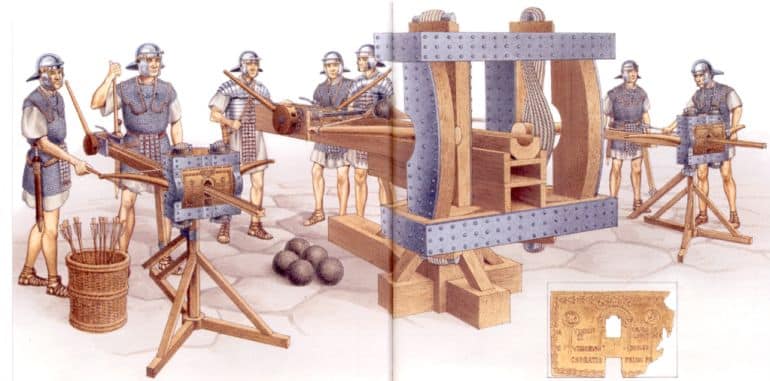
Unfortunately for Vercingetorix, while his strategy was taking its toll on Romans, he was convinced to defend Avaricum from his foes, possibly due to the good defenses presented by the oppidum. And that is where Caesar took his opportunity to pin down his enemies, a feat quite remarkable considering that his army had to build a gargantuan terrace (330 ft width and 80 ft height) in just 25 days, through the only gap of the town’s natural defenses.
However, beyond engineered terraces, the Roman advantage when it came to siege battles, was arguably related to their usage of various mechanized weapons. The catapults are the prime example of such an advanced tactic, with two types mainly operated by Caesar’s army in Gaul – the ballista (for throwing stones) and scorpion (for shooting heavy crossbow-like bolts).
And while stone-throwing siege weapons like ballistae were useful for breaking down rudimentary fortifications, they were not so effective (unlike simpler battering rams) against some Gallic oppidum designs that entailed a reinforced combination of earth, timber, and stone ramparts.
On the other hand, the less-bulky scorpions were rather used as anti-personnel weapons, while at the same being more modular in design allowed them to be transported quite easily by the Roman engineers. So matching up with the modus operandi of Caesar’s fast deployment and attacking stratagem, these artillery weapons were crafted to be precise and even silent – in a bid to catch the enemy unaware of the deadly projectile coming his way.
In essence, the scorpions proved their value in various engagements during the Gallic Wars, with one particular example pertaining to the siege of Avaricum when the Gauls tried to set fire to the aforementioned terrace. Targeting them from afar, the Roman army scorpions caused massive casualties among the desperate (and even suicidal) Gallic warriors attempting to fire the constructed passage.
This ultimately led to the breach of Gallic defenses, and the Romans vented their winter-long frustration on the town inhabitants by looting and pillaging that had resulted in thousands dead (according to Caesar, the heinous figure stood at 40,000).
The Defense of Gergovia (circa 52 BC)
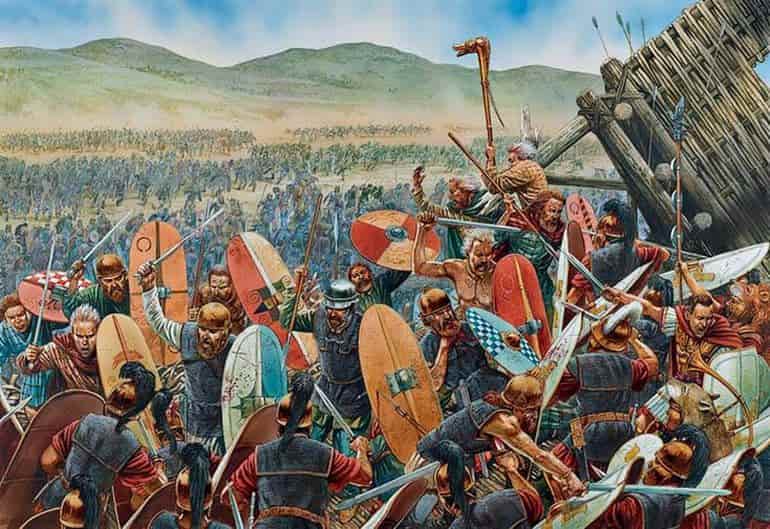
The sacking of Avaricum was undoubtedly a setback for the Gallic coalition, and the next target for Caesar (circa the spring of 52 BC) would pertain to Gergovia, the fortified stronghold of the Arverni, the tribe of Vercingetorix. But unlike in the case of Avaricum, the Gallic noble was fully willing to defend his ‘home’ oppidum.
This may have been due to the rigorous hilly terrain that dominated the surrounding landscape of the hill fort, which would have made its defense more effective. Caesar, on the other hand, was bolstered by fresh supplies with the start of a new campaign season, which logistically allowed him to bring forth an impressive force of six legions.
And with typical Roman resourcefulness, Caesar was able to successfully capture a few hills around the parameter of the main hill-fort. These actions might have even resulted in the Roman interception of the principal water supply of the oppidum, and thus effectively gave Caesar an advantage before his planned final assault on Gergovia itself.
However, confusions mitigated any such military leverage, with Caesar mentioning (in his Commentarii de Bello Gallico) how some of his forces acted prematurely by directly attacking the walls of the hill-fort after capturing a nearby connecting hill.
The aggression, possibly led by some impetuous centurions, had cost the Romans dearly, with Gallic defending forces inflicting over 700 Roman fatalities (46 of them being centurions). Now when it comes to unbiased history, scholars are still not sure if it was a serious miscommunication or an uncharacteristic error on the part of Caesar himself (considering he distanced himself from the failure).
In any case, the loss of so many officers curtailed the maneuvering capacity of the besieging Romans, and thus Caesar was forced to withdraw from Gergovia, resulting in a rare Gallic victory – which further enhanced the reputation of Vercingetorix.
The Momentous Siege of Alesia (circa late 52 BC)
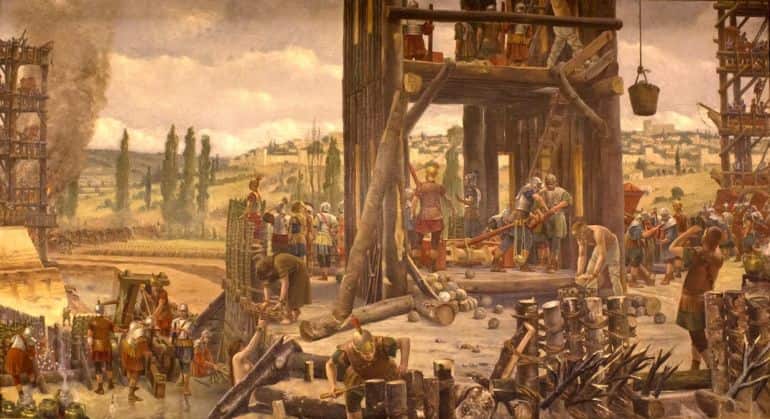
So the stage for the showdown at Alesia was set, with Caesar being determined not to repeat his miscalculation at Gergovia and Vercingetorix being confident after his recent success against his foe. In fact, the latter was so self-assured that he allowed his forces to be hemmed in at Alesia, a large hill fort situated on a plateau 30 miles north of modern Dijon. His plan was to raise a separate relieving army that could catch the besieging Romans in a pincer movement with the help of the defending forces inside the oppidum.
But Caesar had other plans to counter his outnumbering foes (with possibly over 80,000 men), with his adopted strategy pertaining to the use of a grandiosely conceived circumvallation of the hill fort. This extraordinary feat of Roman military engineering (and ingenuity) translated to a massive ditch on the plains to mitigate cavalry attacks on the workers.
As a result, the protected working parties were able to construct a fortified rampart with palisades and even towers in regular intervals, accompanied by double ditches, seven camps, 23 redoubts, and a flurry of booby traps (comprising hidden pits with sharpened stakes and barbed iron spikes). The inner line of his impressive circumvallation covered 11 miles, while the outer line (to counter the Gallic relieving army) encompassed 14 miles; and the entire defensive system was built in a month.
Caesar didn’t even order an assault on Alesia itself, and thus the Gauls had to take the bait and sally out to attack the encircling Romans. And while these aggressive maneuvers were pretty well coordinated with the ‘outer’ relieving army, the imposing defensive siege works of the Romans ultimately proved to be an effective bulwark – so much so that starvation was an inevitable outcome for the defenders of Alesia. Finally, the relieving force disbanded and Vercingetorix unceremoniously surrendered from ‘within’, thus signifying the defeat of organized Gallic resistance.
The Last Oppidum (circa 50 BC)
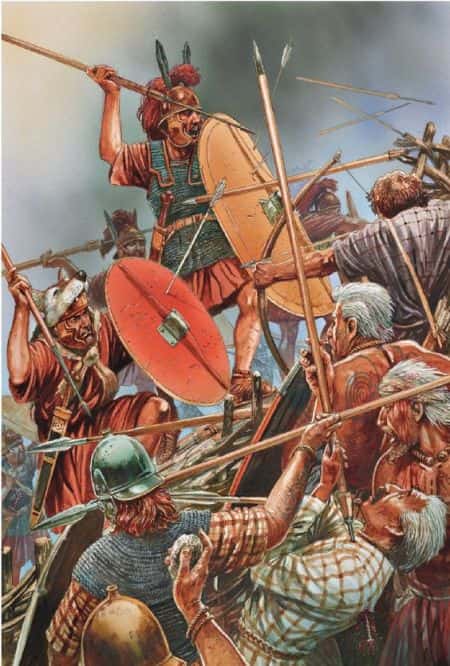
By 51 BC, the Roman legions had established their dominance over most of Gaul, with both Gallic and Belgic tribes bearing the brunt of Caesar’s punitive actions over the winter. However, in 50 BC, southwestern Gaul was still offering resistance to Caesar, bolstered by the strongly-fortified oppidum of Uxellodunum.
Their leaders Drappes and Lucterius were already experienced in dealing with Roman tactics, and as such even led sorties (to collect supplies) against the almost ‘standard’ circumvallation of the hill fort by two legions. Unfortunately for the Gauls, Roman reinforcements arrived in a timely fashion to inflict a serious defeat on their foraging parties.
Consequently, the defenders made their stand inside the well-protected oppidum, still supplied by an external spring. The Romans took advantage of this strategic weak point and surrounded the water reservoir with engineered siege ramps and towers. In response, the trapped Gallic forces tried rolling flaming casks towards the besieging forces, but in vain with the Romans being able to diffuse the incendiary objects.
And finally, the Romans even managed to bore underground tunnels that caused the spring to dry up. The Gauls saw it as divine intervention and abruptly surrendered. Caesar went on to unceremoniously punish (most of) the defenders by cutting off their hands and thus ended the bloody historical episode of the Gallic Wars.
As a result, most of the Gallic tribes accepted the Roman sphere of military control, and the conflict ironically heralded the mercurial political climate of Rome that would catapult the victors into a civil war of their own.
Conclusion – The Slavery Factor
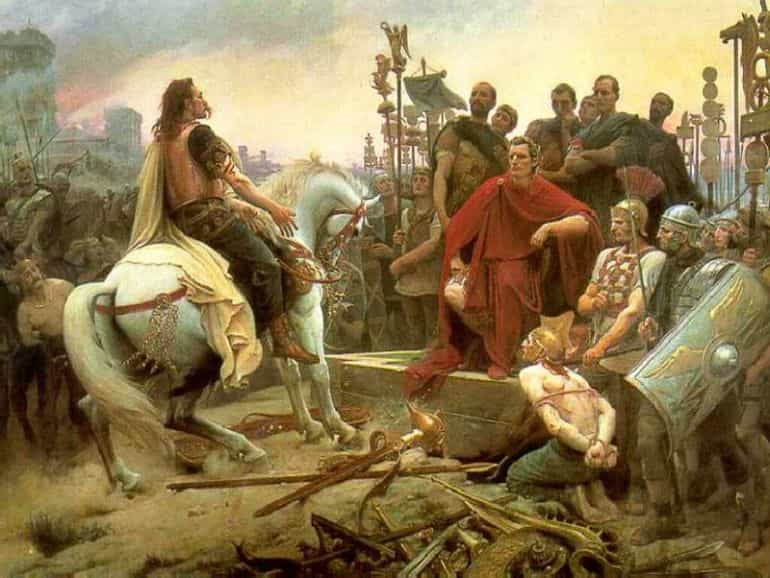
Without a shred of doubt, the Gallic Wars not only resulted in an appalling loss of human lives but also dreadful damages to the relatively rural infrastructure of Gaul (brought on by both the resource-consuming advancing Romans and the scorched earth policy of the defending Gallic tribes).
In fact, according to Caesar himself, his conquering forces inflicted fatalities that went beyond tens of thousands in punitive actions that followed hard-won sieges and battles – and these figures abhorrently also included women and children (like in the case of the butchering of Germanic tribes Usipi and Tencteri).
But objectively, the overall Gallic Wars entailed a profitable though long-drawn endeavor for the Romans; especially Caesar who had bankrupted himself in 63 BC. This scope of profitability was fueled by the rampant acquisition and selling of slaves – a very lucrative source of income in the ancient world.
Slaves (in high numbers) were readily available after wars of conquests, from prisoners-of-war and even ordinary civilian tribal members. To that end, Caesar himself claimed how he had sold around 53,000 members of the Aduatuci tribe (including men, women, and children) after a particular incident in which they feigned surrender and attacked the Romans in 57 BC.
It should also be noted that this very scope of the slave-based economy was monetarily more effective when slaves could be acquired in very large numbers. And while back in Rome, Gallic slaves were often looked down upon as being ‘barbaric’, they were used as nominal laborers who could break their backs in the agricultural fields, mines, and quarries.
Interestingly enough, on the other side, the Gallic warlords (before Caesar’s campaign) also engaged in slave-trading activities with the Romans, in a bid to gather luxury goods like wine and gold coins. Now while for a Mediterranean merchant, the deal was seen as being ‘too easy’ – since slaves were often more profitable than mere fixed commodities, the trade was practical for a Gallic warlord. That is because the acquisition of wines (and luxury goods) and their distribution among his retainers would actually reinforce his standing within the tribe structure.
Sources: HistoryNet / Livius / University of Chicago
Book References: Commentarii de Bello Gallico (by Julius Caesar – translated by W. A. McDevitte and W. S. Bohn) / Caesar’s Gallic Wars 58-50 BC (by C M Gilliver, K. M. Gilliver)
Featured Image Credit: Fall3NAiRBoRnE (DeviantArt)
And in case we have not attributed or misattributed any image, artwork, or photograph, we apologize in advance. Please let us know via the ‘Contact Us’ link, provided both above the top bar and at the bottom bar of the page.
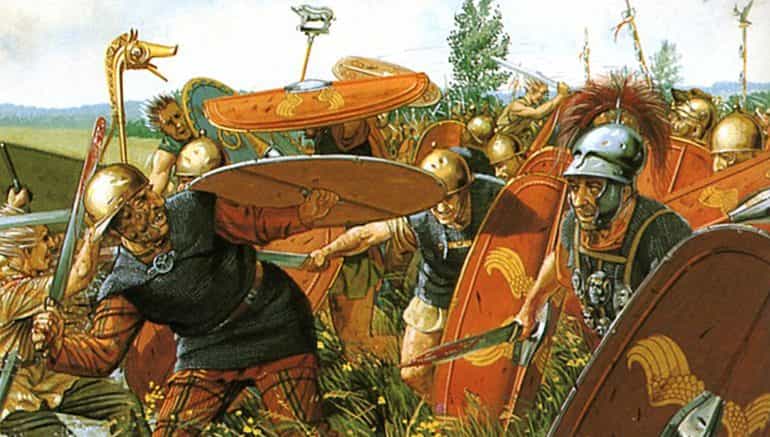
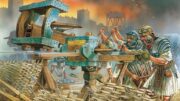
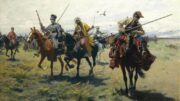


Be the first to comment on "The Remarkable Gallic Wars: History, Armies, and Tactics"